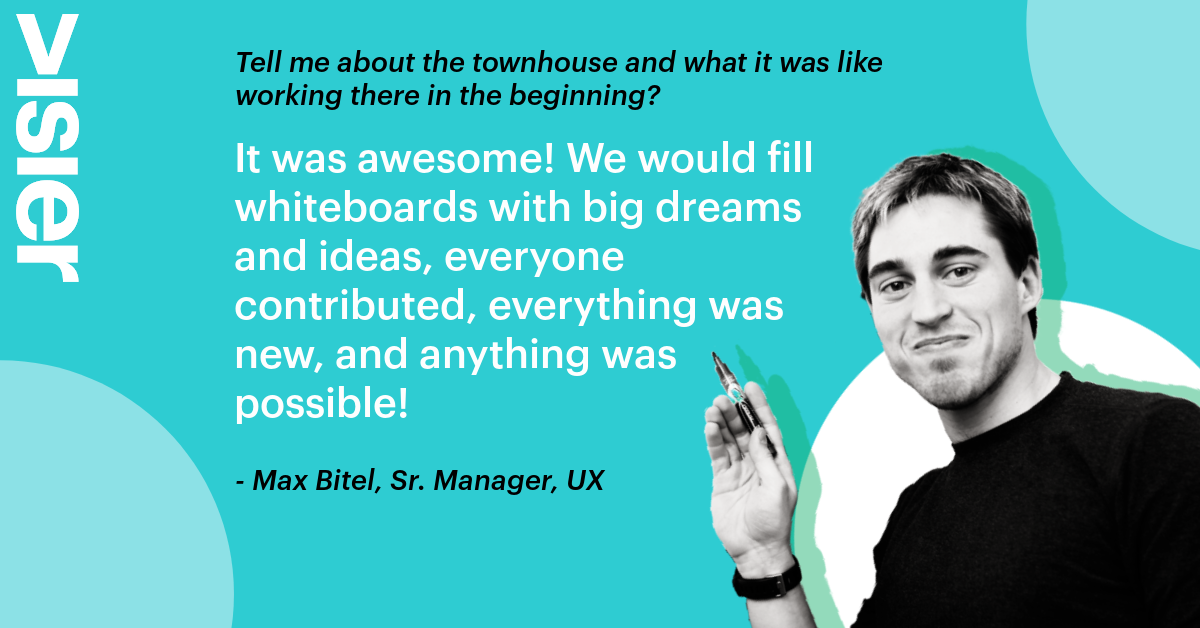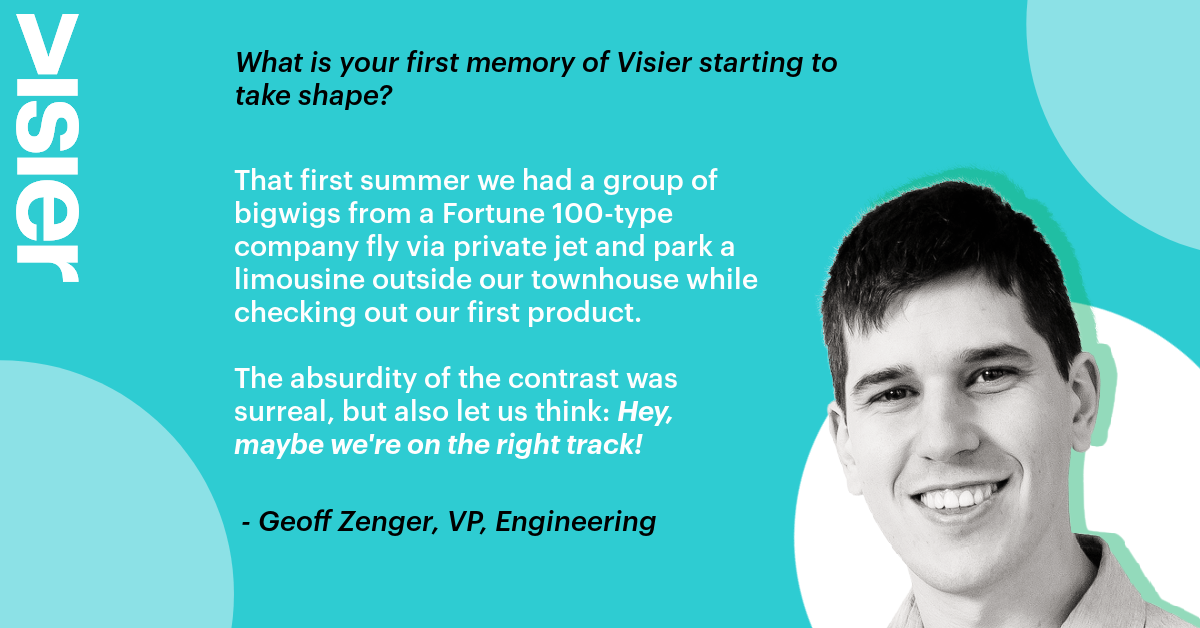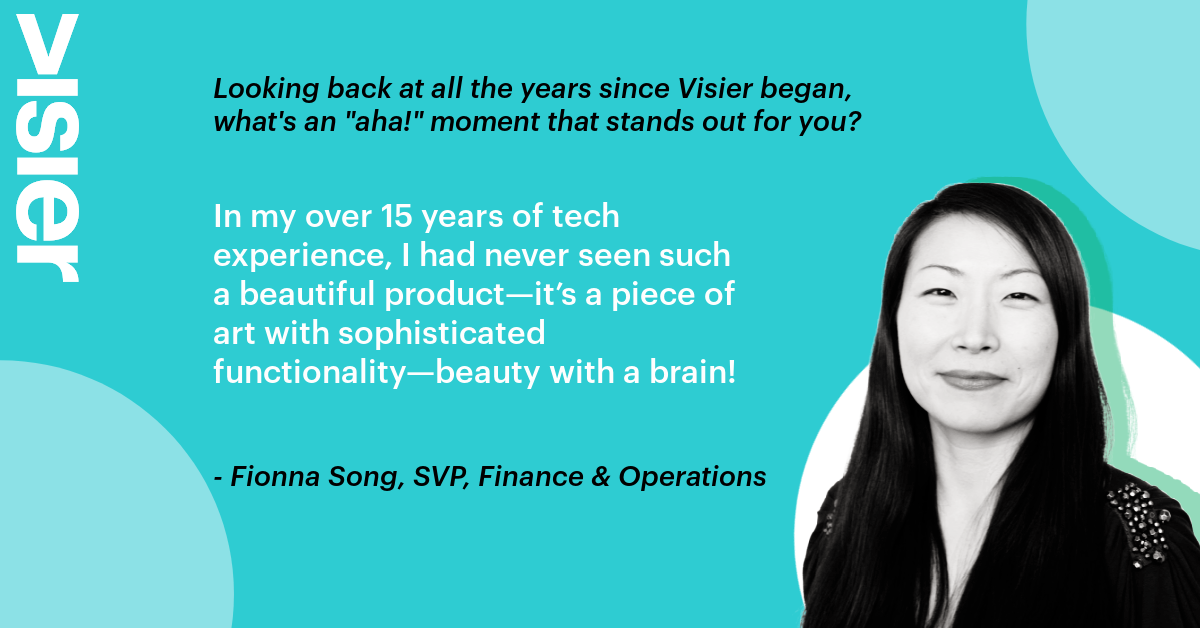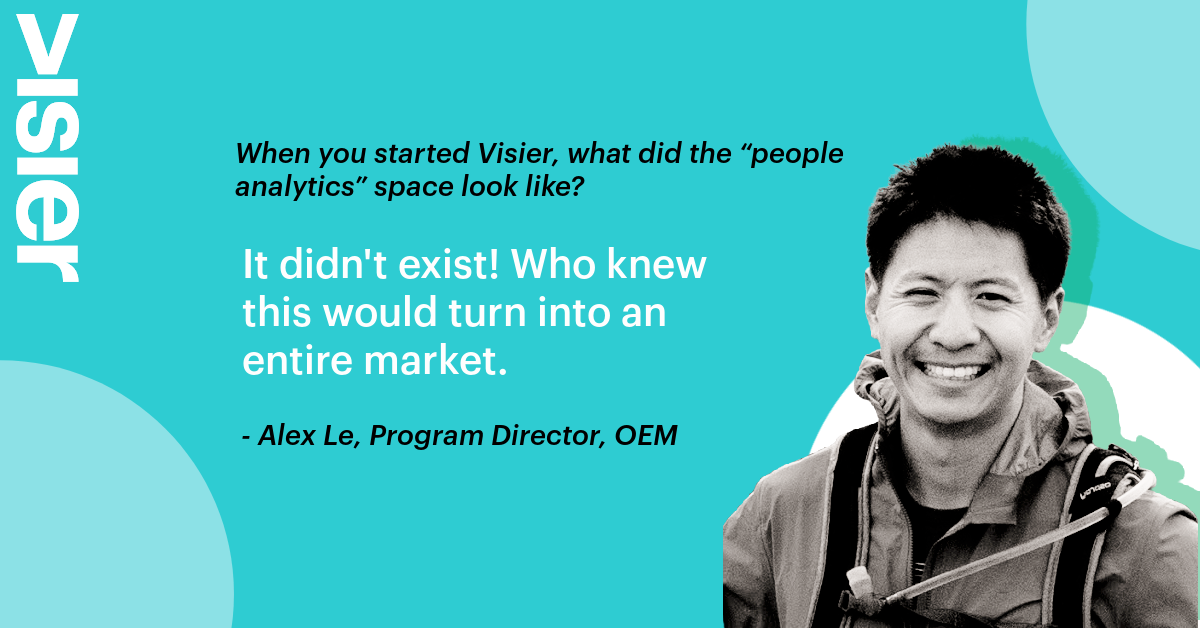The Road to One Billion: The Founders of Visier Recall the Years Leading to Unicorn Status
In their own words, Visier's original founders tell the story of when they began Visier in 2010 to a one billion dollar valuation this month.

Employees 1 & 2: Co-founders Ryan Wong (current CEO of Visier) and John Schwarz (current Chairman of the Board)
In their own words, Visier’s original founders—”The Townhouse Crew”— tell the story of when they began building Visier from a small, Vancouver townhouse in 2010, and how they brought the company to unicorn status with a one billion dollar valuation this month.
In 2010 a group of self-described “data geeks” put their heads together, their full-time jobs on notice, and decided to start a new kind of business. This innovative new start-up recognized that there was a better way to analyze HR data—but the HR market didn’t yet know it.
“Everyone was using legacy tools like Crystal Reports or Tableau to do analytics the hard way,” explains co-founder and Director of Information Security Michael Burgener about the state of the people analytics space in 2010. “Insights and predictions were not even a thing, let alone a SaaS company to do all the hard work for you—we literally had to create the market to sell our product to.”
Clearly Burgener and the rest of that early team, which included current Visier CEO, Ryan Wong, captured the market they helped to create over the last 11 years. To mark the major milestone event of closing $125M in Round E funding from Goldman Sachs which resulted in a $1B valuation, the founders of Canada’s newest tech unicorn cast their memories back to the start—beginning with a very hot, 1500 square foot townhouse in Vancouver.
What is your first memory of Visier starting to take shape?
Geoff Zenger (VP, Engineering): Those first few months were intense as we built our first beta application, onboarded our first pilot customers, and worked towards our first unveiling.
Alex Le (Program Director, OEM): I remembered celebrating our first round of investment with Foundation Capital which was a relief because it meant I was going to keep getting a paycheck!
Michael Burgener (Director, Information Security): And landing our biggest deal at the time with CBA (Commonwealth Bank of Australia) who is still a significant customer today.
Ryan Wong (CEO): Our road to the first ten customers we closed. Receiving our first customer payment of an amount that, in today’s standards, would seem extremely low, but back then we were thrilled.

Fionna Song (Sr. VP, Finance & Operations): I joined Visier just over six years ago and I still clearly remember the fast and furious energy on my first day. We didn’t have the luxury of large standing desks or ample meeting rooms with teleconference equipment or the office support including snacks (although we did take turns stocking fruit and sodas from Costco!). Those who enjoy being a part of a rocketship will appreciate these are signs of a takeoff. I loved the energy of urgency, being creative and appreciative of scarcity, being one team whose single focus is growth and whose dream is to become a “unicorn!”
Zenger: One moment that sticks out in my memory was a day that first summer when we had a group of bigwigs from a Fortune 100-type company fly via private jet and park a limousine outside our townhouse while they checked out our first product.
Max Bitel (Sr. Manager, UX): We had to clean up all the empty Coke cans and takeout containers and make the place look presentable when they met in the “boardroom” which was the bedroom upstairs! The demo consisted of John Schwarz demoing a click-through “prototype” of mostly mock-ups showing a bunch of cool data visualizations we wanted to maybe build.
Zenger: The absurdity of the contrast—limousines and take-out containers—was surreal to witness, but also let us think: “Hey, maybe we’re on the right track!”
Le: And it’s not so different this round—it’s great to see that we’ve been going down the right path for the past 11 years with lots more room to grow.

“The Townhouse Crew” of Visier’s original founders blowing off a little start-up steam in between marathon coding sessions
Tell me about the townhouse and what it was like working there in the beginning?
Wong: It was cozy in the winter and very, very uncomfortable during the summer.
Zenger: Terribly hot.
Bitel: We had all these servers and computers running in a small space—there was no AC and it was very hot.
John Schwarz (Co-founder & Chairman of the Board): Hot and noisy. Construction across the street was driving us nuts. But it was also very productive—we would be constantly meeting, changing, testing new ideas, and visualizations. We had weekly sprints with real working code.
Le: Opening the window for a breeze wasn’t an option due to the construction so we just put on our headphones and coded in the heat, sweating away.

Burgener: We could see the pace of innovation on a weekly basis during our demo sessions with John and the sales team.
Zenger: We had a bit of a “Silicon Valley” vibe going on with everyone crammed around a few small tables built from old doors acquired at auction, a small patio, and a barbeque to cook ourselves lunch. For a while we even had our 1U servers stacked on top of each other on the kitchen counter.
Wong: At the peak, we had 13 employees working in the townhome, and even then it felt cramped.
Le: I remember on numerous occasions pulling all-nighters and working weekends to make lofty goals and meet tight timelines. We all came together to get it done. I think that was a big contributor to our success then and that culture lives on today!
Bitel: It was awesome—we would fill whiteboards with big dreams and ideas, everyone contributed, everything was new, and anything was possible! On Fridays we’d always have a BBQ—we’d go around the room and folks would demo their work from the week, holding tasty Mexican lagers—there were so many good ideas and always a lively discussion.
When you founded Visier, what did the “people analytics” space look like?
Bitel: It wasn’t really a thing. There were all these BI tools like SAP, PowerBI, and Tableau—but the idea of an analytics solution didn’t exist.
Le: It didn’t exist.
Zenger: Analytic tools, as they existed at the time, were a ripoff—designed to generate billable hours rather than deliver answers to the questions that mattered to someone’s business. There was essentially a complete void in the space.
Bitel: And then there were all these consulting companies doing one-off stuff. It was a field prime for disruption!
Wong: I don’t think the name even existed at the time. We called our project “Workforce Analytics.” There were mostly either reporting features in major HCM systems, or spreadsheets; not even custom builds via BI tools.
Zenger: There simply wasn’t anyone out there building software for HR business partners and people managers, asking what questions do they want answers to, and designing workflows tailored for business people rather than analysts.
Le: Who knew this would turn into an entire market!

Song: Many felt and believed that people analytics were important but hadn’t quite gotten to the point of its necessity, which is a classic analogy of vitamin vs. painkiller. I strongly believe this has been changing and people analytics will become a must-have over the next few years as we have seen in the case of other markets.
Schwarz: People analytics was basically all about single-application reporting status. No real analytics were being done. Nothing predictive, nothing based on machine learning or even weighted driver factors, nothing based on integrated data from diverse sources.
Looking back at all the years since Visier began, what’s an “aha!” moment that stands out for you?
Zenger: The first highlight that comes to mind is the initial release of our own in-memory analytic database. By late 2011 we had our first customers live, but it was becoming clear that to get the combination of flexibility, performance, and data security that we wanted to give our customers, we’d need to develop our own database from scratch, so a few of us worked hard over the Christmas holiday and released it to production a few weeks later in early 2012.
The second came in early 2017. Our fiscal year ended in January and our sales team had just killed it. We were awash in new customers with all sorts of interesting data requirements, and very quickly it became an all-hands-on-deck experience with about 15 devs transferred to a special project to serve all the new customers, and those of us remaining on the platform development side scrambling to grow up fast! We passed the trials with glowing colors and the scalability, usability, reliability improvements that came out of that intense phase put us on track to eventually onboard thousands more customers.

Le: I saw Visier grow literally from the first line of code. It was, at the time, modern, beautiful, and was the first of its kind. I spent years adding features and enhancements because I thought product is the biggest factor of success. When I moved to the customer success side and started talking to customers who were using the product that I had built I realized there’s far more to success than just having a good product. I realize that more and more now and, as we mature as an organization, we need to continue not only improving the product but just as importantly focus on making ourselves heard in the market and enabling the entire ecosystem of users and implementers to be successful.
Song: In my second week, I had an opportunity to check out our product. In my over 15 years of tech experience, I had never seen such a beautiful product—it’s a piece of art with sophisticated functionality, beauty with a brain! IP (Intellectual Property) is at the core of any tech company, helping with a company’s valuation. Many tech companies come up with a mediocre product and immediately focus only on selling without further innovation. They may achieve some growth or be able to raise some funding, but then shortly after they’ll die because there is no strong IP to sustain growth or become an acquisition target. This is not the case with Visier.
Why do you think the market for people analytics has grown so much in the last decade?
Zenger: People are at the center of every decision in modern business, plain and simple. Whether you’re building software, running a retail bank, or delivering the services needed to keep a hospital or a grocery store running, your outcomes are tied to your people, and people analytics is what lets companies use data to shine a light into their business and uncover what’s needed to keep them successful.
Schwarz: And people are expensive—hard to find and hard to keep. Management by gut feel isn’t good enough. One needs forward looking data and models to design the right policies and to measure performance.
Bitel: Companies have so much data on people, yet do so little with it. People and talent are at the core of the success of so many companies, it only makes sense that these companies should be making business decisions using people data!
Burgener: From a technical perspective, IT departments did not have the people resources or knowledge on how to provide meaningful solutions… But when you understand that Visier can provide value in a couple months with experts to guide customers, it’s easy to understand our success.
Wong: Also on a macro-level, there is a widespread realization of the importance of holding enterprises accountable for their social responsibility and sustainability policies. There’s a new awareness of DEI and loud demands for a just and fair society. We have an aging workforce and, therefore, a new generation of workers. Enterprises are realizing how their people impact business outcomes.
What does it feel like to be a co-founder of a “unicorn” tech company?
Schwarz: Pretty special. But no matter how good we are, there are always companies that have done better than we have. So we need to keep our aspirations lofty and not to rest on our laurels as a unicorn.
Wong: Exciting but stressful. We are playing in a different league. Nobody is going to give us a break as a startup company anymore. So, we have the pressure to perform and meet the big expectations.
Zenger: Thrilling! After the first years of heads-down intensity, getting our first customers, and building out our platform, there are many moments where you wonder: is it all worth it? Will our sweat amount to anything or will we fizzle out? This latest funding round and joining the “unicorn” ranks feels great because it’s validation of a decade of hard work. We have a huge amount of depth in our tech stack and I can’t wait to open up our platform and open up our value to the world!
Le: It feels a bit surreal to be honest. It’s incredibly exciting but I’m more excited about what’s to come! We still have lots of work left to do!
How are you celebrating the $1B valuation?
Schwarz: Quietly. I will celebrate when we can turn the private paper into a public currency.
Zenger: I’m going on a three-week sabbatical to take some time to enjoy British Columbia before coming back and tackling whatever’s next in our journey.
Song: Celebrations have already begun and the whole company will celebrate together in early August! To me, reflecting on our journey, being proud of ourselves on how far we have come and refocusing for the next phase are celebrating.


